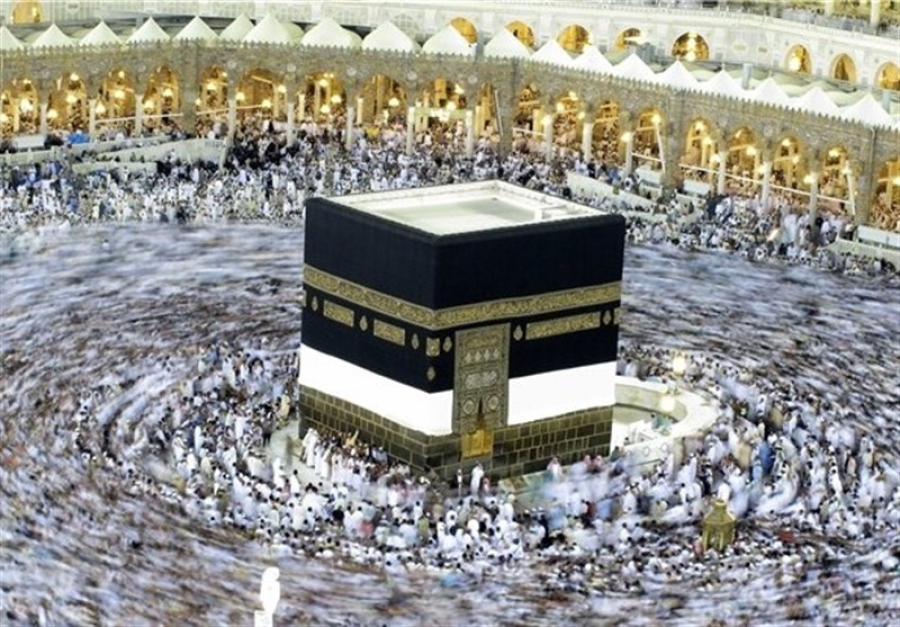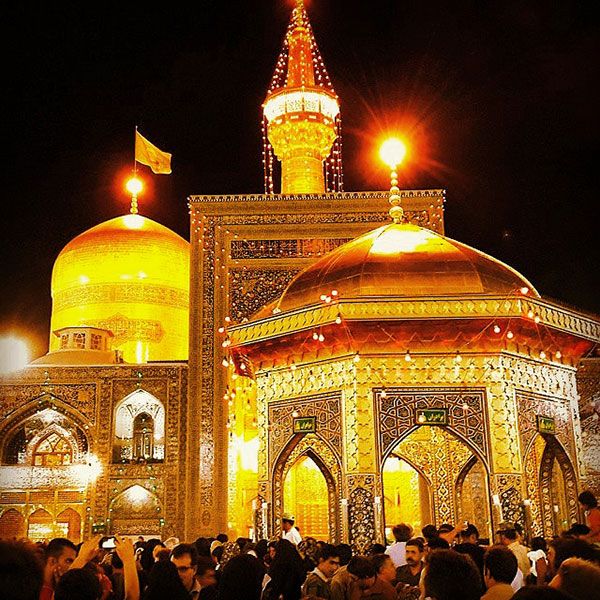On Obligations Of Tawaf
First: Prerequisites Of The Tawaf
A. Niyyah
B. One should be pure of hadath Akbar and hadath asghar
One should be pure of hadath Akbar (such as janabah, haydh, and nifas) and hadath asghar (i.e. he should have wudhu after passing of gasses or after coming from toilet).
Tawaf of a person with hadath Akbar or asghar is null and void, whether willful or due to negligence, forgetfulness, or unawareness.
If hadath asghar occurs during tawaf (after the completion of the fourth round), he should stop and gain taharah. Afterwards, he should start from where he left off and complete the tawaf. If the hadath occurs before completing half of the fourth round, it is wajib to stop, gain taharah and then complete it. Likewise if hadath asghar occurs before half the fourth round (namely before completing the fourth round), he should stop, gain taharah and then complete it as ma fil-dhimmah.
Taharah from hadath akbar and asghar is not a precondition for a recommended tawaf.
If during tawaf, hadath akbar (such as janabah or haydh) occurs, the pilgrim should immediately leave the Masjid al-Haram. If this happens before half of the fourth round, he should complete it after ghusl. If it happens after half of the fourth round, he should again complete it after ghusl as ma fil-dhimmah.
If during the obligatory tawaf, the pilgrim has an excuse not to engage in wudhu or ghusl, it is obligatory to perform tayammum and then embark upon the tawaf.
If during the tawaf, he doubts whether he has performed the wudhu or the ghusl, he should disregard his doubt if he has already had taharah; otherwise, he should engage in taharah and complete the tawaf.
C. Taharah of the body and the clothes from nijasah or impurities
If during tawaf, the pilgrim's body or clothes become najis in such a way that purification would is impossible while performing the tawaf, he should stop, purify the clothes or the body, immediately return, and complete the tawaf from where he left off. His tawaf would be correct.
Apparently the previous hokum also applies to a case in which he realises that his body or clothes have become najis during tawaf and supposes that nijasah has occurred during tawaf.
If he forgets about the nijasah in his body or clothes and performs the tawaf but remembers it during the tawaf or afterwards, he should, based on ihtiyat wajib, perform tawaf all over again.
The type of bleeding that is excusable during prayer is not excused in tawaf. Taharah is not requisite for items such as socks, skullcaps, handkerchiefs, and rings.
D. Covering naked parts of the body
Based on necessary precaution, covering naked parts of the body is a precondition of tawaf.
E. Circumcision
Circumcision is a prerequisite for men's tawaf to be correct. This hukm applies to both the mature and the immature males.
Second: Essential Elements Of Tawaf Are Seven In Number
A. Commencing at the Hajar al-Aswad (the Black Stone of the Kabah).
While commencing at the Hajar al-Aswad, all parts of the pilgrim's body do not have to face all parts of the Hajar al-Aswad.
It is obligatory to start from any part of the Hajar al-Aswad and end where he started. For the sake of certainty, he can make the niyyah a little before the Hajar al-Aswad and start the tawaf while reaching its parallel areas and end where he started.
It is obligatory to start and end the tawaf at the Hajar al-Aswad in the commonly understood sense, whether at the beginning, the middle, or the end of it.
The seventh round should be completed at the point where one started the tawaf. As a result, if he started the tawaf at the beginning of the Hajar al-Aswad, he should end it at the same place. Likewise, if he started at the middle or the end, he should complete the tawaf at the same place.
As with all Muslims, the pilgrim should start the tawaf at the parallel areas of the Hajar al- Aswad without meticulousness shown by those having scruples. The seven rounds should be completed without any halt.
B. Ending each round at the Hajar al-Aswad
This can be done through completing the seven rounds without any halt. The seventh round should end at the same point where the pilgrim started the tawaf. It is not necessary to halt after each round and then commence a new round.
C. The Kabah should be on his left during tawaf
D. The Hijr Ismail must be included in tawaf
The Hijr Ismail must be included in tawaf. Hijr Ismail is linked to the Kabah and the pilgrim should circumambulate it.
If he does not circumambulate the Hijr Ismail and passes between it on all rounds, his tawaf will be null and void and should be performed all over again.
If in some rounds he does not circumambulate the Hijr Ismail, it is obligatory to repeat the relevant rounds. If this is not done and he continues the tawaf, the tawaf will be vain and void and must be performed all over again.
E. Tawaf should be performed between the Kabah and Maqam Ibrahim
It is held that tawaf should be performed between the Kabah and the rock called Maqam Ibrahim (Station of Abraham) on all sides. But based on the aqwa, there is no obligation in this act.
There is no limitation for mataf. Tawaf is permissible up to any part of the Masjid al-Haram in which tawaf would be regarded as the tawaf of Kabah. If there is no crowd and exigency, it is mustahabb to perform tawaf between Kabah and Maqam Ibrahim.
F. Covering the Kabah and whatever is part of it
There is a projected part called Shadhrawan around the walls of the Kabah. Shadhrawan is part of the Kabah and should be included in the tawaf.
It is permissible to place the hand on the wall of the Kabah at the Shadhrawan, and this act will not invalidate the tawaf.
It is permissible to place the hand on the wall of Hijr Ismail during tawaf and this act will not render the tawaf null and void.
G. The tawaf should consist of seven rounds, no more, no less
If upon returning to his country, the pilgrim realises that his tawaf has been incompletely performed, he must return and correctly perform the tawaf and its prayers. If he cannot return, he should hire a naib.
If during tawaf, he faces hadath before reaching half the fourth shawt (namely reaching the parallel of the Kabah's third pillar), he should dispense with the tawaf, perform wudhu, and start the tawaf all over again. If the hadath appears between half the fourth shawt and the end of this round, he should dispense with the tawaf, perform wudhu, and then engage in a complete tawaf as ma fil-dhimmah. If the hadath occurs after the completion of the fourth shawt, he should stop the tawaf, perform wudhu, and then carry out three other ashwat. If he faces hadath akbar during tawaf, he should immediately leave the Masjid al-Haram and perform ghusl. If the hadath akbar happens before completing half of the fourth shawt, his tawaf will be vain and void and should be performed anew. If hadath akbar occurs after completing half of the fourth shawt, he should perform a complete tawaf as ma fil-dhimmah.
If he mistakenly, negligently, or unknowingly performs the tawaf, without wudhu, his tawaf will be invalidated. The same applies to engaging in tawaf while in the states of janabah, haydh, and nifas.
If due to illness or brevity of time, a muhrim cannot perform the tawaf, he should be assisted and taken (by others) for tawaf. If this is not possible either, he should hire a naib.
Based on necessary precaution, muwalat should be observed during the tawaf. This does not apply to halting the tawaf after completing half of its rites to perform prayer and the like.
If during the obligatory tawaf, he halts for daily prayer after having completed at least half of the required rounds (namely three and a half ashwat), he should continue the tawaf from where he left off. If he has completed less than three and a half ashwat, based on ihtiyat, he should perform the tawaf all over again if the time gap is long. But if the time interval is not long, this ihtiyat might not be wajib and is mustahsan. In the relevant Ahkam, there is no difference between congregation or individual prayers or abundance or brevity of time.
Secondary Issues Related To The Tawaf
If upon completion of Hajj at-Tamattu, the muhrim realises that he has passed through the Hijr Ismail during several of the ashwat on tawaf of Umrah or Hajj, his Hajj will be correct, and he should only perform tawaf and its prayer all over again.
If after taqsir in Umrah Tamattu, he realises that his wudhu was null and void or was not performed and that he has, nonetheless, engaged in tawaf and its prayer, he should perform tawaf and its prayer anew, and thus his Umrah will be correct.
There is no problem in halting the tawaf. But based on ihtiyat mustahabb, the obligatory tawaf should not be halted in such a way as to disrupt its muwalat.
One who has to perform jabirah wudhu and tayammum but who has ignorantly completed Umrah rites without tayammum should perform tawaf and its prayer all over again.
If a woman's hair or parts of body, which should be covered during tawaf, are deliberately uncovered, her tawaf will be correct but she has committed a sin.
It is permissible to perform the tawaf in the upper floor, which would be parallel to the ceiling of the Kabah. But based on ihtiyat, this should be dispensed with.


















